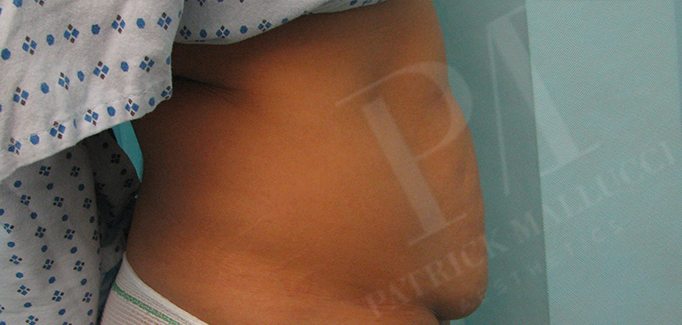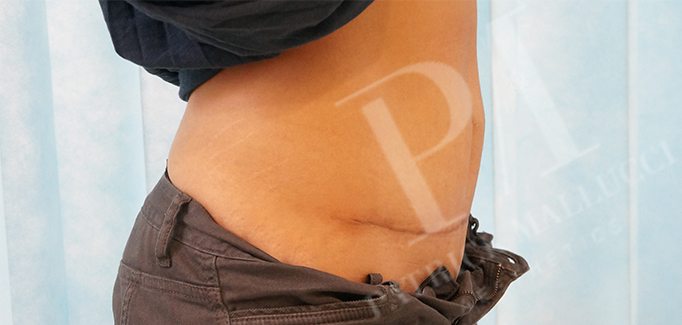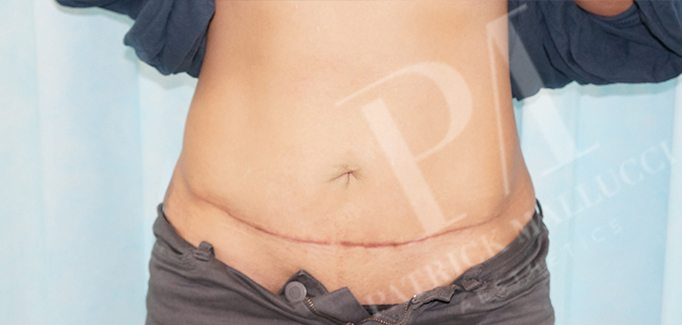A surgical procedure designed to remove excess skin and fat from the middle and lower abdomen. It can also improve muscle tightness and skin tone especially after multiple pregnancies or dramatic weight loss where skin has been stretched on the abdomen.
Abdominoplasty, more commonly known as a 'tummy tuck', is a surgical procedure designed to remove excess skin and fat from the middle and lower abdomen.
You may choose to undergo abdominoplasty for a number of reasons:
- To remove a large fat deposit
- To remove loose abdominal skin
- To improve skin elasticity if you are an older patient
- To improve your muscle and skin tone after multiple pregnancies
“I had a wonderful experience with Patrick, he is not only a great surgeon but he has extraordinary empathy and I always felt totally at ease with him.”
The following frequently asked questions and answers (FAQs) will give you a basic understanding of the procedure – when it can help, how it’s performed, and what results you can expect. These may not answer all of your questions, since a lot depends on your individual circumstances.
-
What should I consider before having abdominoplasty?
Abdominoplasty can enhance your appearance and your self-confidence, but it won’t necessarily change your looks to match your ideal, or cause other people to treat you differently. Abdominoplasty surgery should not be seen as a short cut to losing weight – it is a risky procedure in overweight individuals.
Before you decide to have Abdominoplasty think carefully about your expectations and discuss them with your surgeon.If you intend to lose weight it is advisable to postpone the Abdominoplasty surgery. Likewise, if you plan to have future pregnancies it makes sense to wait, as the vertical muscles in the abdomen that are tightened during Abdominoplasty surgery can separate again during pregnancy, also skin can re-stretch if you have scarring from previous abdominal surgery, your doctor may recommend against Abdominoplasty or may caution you that scars could be unusually prominent.
The best candidates for Abdominoplasty are men or women who are in relatively good shape but are bothered by a large fat deposit or loose abdominal skin that won’t respond to diet or exercise. The Abdominoplasty surgery is particularly effective if, through multiple pregnancies, you have stretched your abdominal muscles and skin beyond the point where it can return to normal. Loss of skin elasticity in older patients, which frequently occurs with slight obesity, can also be improved. -
How do I plan my abdominoplasty?
Your surgeon will work with you to recommend the procedure most appropriate for you and will come closest to producing the desired body contour. Be frank in discussing your expectations with your surgeon. He will need to know if you smoke, and if you’re taking any medications, vitamins, or other drugs. He should be equally frank with you, describing your alternatives and the risks and limitations of each.
If, for example, your fat deposits are limited to the area below the navel, you may require a less complex procedure called a Mini Abdominoplasty, also know as a Mini Tummy Tuck, which can often be performed on an outpatient basis.
Alternatively, you may benefit more from partial or complete Abdominoplasty done in conjunction with liposuction to remove fat deposits from the hips, for a better body contour. Then again, liposuction alone may create the best result.
In any case, your surgeon will work with you to recommend the procedure that is right for you and will come closest to producing the desired body contour.
Your surgeon will also talk to you about anaesthesia during your consultation.
After your initial consultation with your surgeon, you will meet the Practice Manager who will discuss the various costs involved and the hospital admission process. Insurance companies do not generally consider Abdominoplasty to be a medical necessity and subsequently do not cover the costs of this procedure.
-
How do I prepare for surgery?
Your surgeon will give you advice on how to prepare for surgery. These may include guidelines on eating and drinking, smoking, and taking or avoiding certain vitamins and medications.
If you smoke, you will generally be advised by your surgeon to stop ideally 6 weeks prior to surgery and to refrain for approximately two weeks post operatively. You should avoid sun exposure preoperatively, particularly to the abdomen, as well as stringent dieting, as both can inhibit your ability to heal. If you develop a cold or infection of any kind your surgery will generally be postponed on the advice of your surgeon and the anaesthetist.
Whilst making preparations for surgery, you should arrange for someone to pick you up on your discharge from hospital and drive you home. It is also advisable to have someone to help you around the house for a few days.
-
Where will my Abdominoplasty surgery be performed?
The Abdominoplasty surgery is performed at one of several of London’s best private hospitals, according to your preference and the availability of operating time.
You will usually be admitted on the day of surgery. An overnight stay in hospital is generally advised and you will be discharged home the following day at about 10:00am. If you have the surgery as a day case you will be discharged later that day.
-
What type of anaesthetic will be used?
This procedure is performed under a general anaesthetic, so you’ll sleep through the entire operation.
-
What takes place during the Abdominoplasty surgery?
Most commonly, the surgeon will make a long incision from hipbone to hipbone, slightly above the pubic area. A second incision is made to free the navel from surrounding tissue. With partial Abdominoplasty, the incision is much shorter and the navel may not be moved, although it may be pulled into an unnatural shape as the skin is tightened and stitched.
Next, the surgeon separates the skin from the abdominal wall all the way up to your ribs and lifts a large skin flap to reveal the vertical (rectus) muscles in your abdomen. These muscles are tightened by being pulled closer together and stitched into their new position. This provides a firmer, flatter abdominal wall and reduces the waistline.
The skin flap is then stretched down and the extra skin is removed. A new hole is cut for your navel, which is then stitched in place. Finally, the incisions will be stitched, dressings will be applied, and a temporary drainage tube may be inserted to drain excess fluid from the surgical site.
In partial Abdominoplasty, the skin is removed below the navel. This skin is stretched down, the excess is removed, and the skin is stitched back into place. The incision is usually shorter and the navel itself is not freed as in a full Abdominoplasty thereby avoiding the need for stitches around it.
-
How long will the Abdominoplasty surgery procedure take that the surgeon has recommended?
The length of your Abdominoplasty operation depends on the procedure. Complete Abdominoplasty usually takes two to three hours while partial Abdominoplasty may take an hour or two.
-
What can I expect after my Abdominoplasty surgery?
For the first few days, your abdomen will probably be swollen and you’re likely to feel some pain and discomfort. However, most of this will be controlled by medication prescribed by your doctor. Depending on the extent of the Abdominoplasty surgery, you may be discharged either as a day case or you may have to remain hospitalised for one to three days.
Your doctor will give you advice on showering and changing your dressings. It is also important that you start walking as soon as possible even though you may not be able to stand straight at first.
Surface stitches will be removed in five to seven days, and deeper sutures will come out in two to three weeks. The dressing on your incision is then likely to be replaced by a support garment for some time.
-
How long will it take for life to return to normal?
It may take you weeks or months to feel like your old self again but, if you start out in top physical condition with strong abdominal muscles, your recovery from Abdominoplasty will be much faster. Some people return to work after two weeks, while others take three or four weeks to rest and recuperate. Exercise will help you heal better. Even if you have never exercised before, an exercise program will help to reduce swelling, lower the chance of blood clots, and tone your muscles. It is wise to avoid vigorous exercise though, until you can do it comfortably.
Your scars will be firm and pink for at least six weeks. Then they may remain the same size for several months, or even appear to widen. After several months, your scars will begin to fade, although they will never disappear completely.
-
How will I feel about my new look?
Both partial and complete Abdominoplasty produces excellent results, especially if you have weakened abdominal muscles or excess skin. If you follow a balanced diet and exercise regularly it is also likely that the results are long lasting. If you’re realistic in your expectations and prepared for the consequences of a permanent scar and a lengthy recovery period, you are likely to be pleased with the results of your Abdominoplasty.
-
Does abdominoplasty carry any risk?
Abdominoplasty is a very common procedure carried out successfully on many people each year. Nevertheless, there are always risks associated with surgery and specific complications associated with this procedure include:
Infection is uncommon, and most infections are minor, being treated with drainage and antibiotics. Serious infections are rare and occur in high risk individuals such as smokers, people who are very overweight, and those with certain conditions such as diabetes.
Bleeding is unusual and normally drainage tubes are used to drain away any excess blood and fluid in the immediate post operative period. Drains are usually removed the morning after surgery before discharge home.
Blood clots are also uncommon and the risk of getting one can be reduced by mobilising as soon after the operation as possible.
There is a chance of poor healing resulting in conspicuous scars and this may necessitate a second operation. If you are a smoker you are strongly advised to stop, as smoking may increase the risk of serious complications (including devastating infections) and delay healing.
You can reduce the risk of complications by following your surgeon’s pre and post operative instructions, particularly with regard to resuming physical activity.



